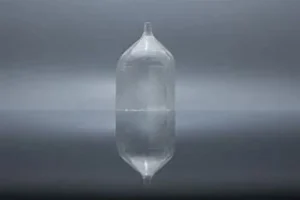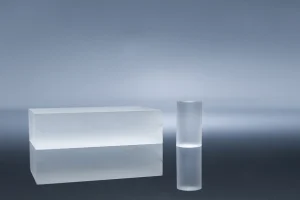Introduction
In the realm of laser technology, the choice of crystal material plays a pivotal role in determining the efficiency, power, and application of the laser. This article delves deep into the various high-power crystal laser materials, such as YAG crystals and silicon-based materials, shedding light on their advantages, limitations, and their significance in laser technology.
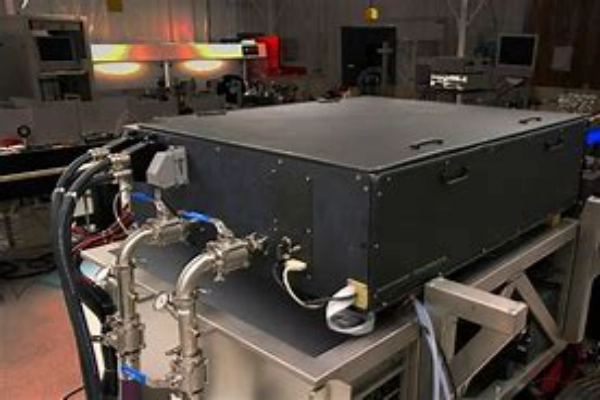
YAG Crystals: The Gold Standard
Yttrium Aluminum Garnet, commonly known as YAG crystals, have firmly established themselves as the gold standard in the world of solid-state lasers. Their widespread usage can be attributed to a combination of unique properties that make them stand out in the vast landscape of laser materials.
At the heart of YAG crystals’ popularity is their exceptional thermal stability. In the demanding environment of high-power laser operations, where temperatures can soar, and stability is paramount, YAG crystals remain unfazed. Their ability to withstand high temperatures without degradation ensures that lasers function optimally over prolonged periods. This thermal resilience not only enhances the efficiency of lasers but also significantly reduces the need for frequent maintenance, making them a preferred choice for industries where continuous operations are crucial.
Another notable feature of YAG crystals is their broad tunability. In simpler terms, these crystals can be adjusted to produce laser beams of different wavelengths. This versatility is a game-changer, especially in applications where precision and adaptability are essential. From medical surgeries that require pinpoint accuracy to industrial applications where different materials might absorb different wavelengths better, the wide tunability range of YAG crystals ensures that they cater to a diverse array of requirements.
Durability is another feather in the cap of YAG crystals. In an industry where the longevity of components can significantly impact operational costs, the robustness of YAG crystals offers a breath of fresh air. These crystals are known to have an extended operational life, ensuring that once integrated into a laser system, they continue to function efficiently for years. This long-lasting nature, combined with their aforementioned thermal stability, means that systems equipped with YAG crystals often have lower downtimes and reduced maintenance costs.
However, as with all things, YAG crystals are not without their challenges. One of the primary concerns associated with them is the cost factor. Producing high-quality YAG crystals that meet the stringent requirements of high-power lasers can be an expensive affair. The synthesis process, which ensures the purity and integrity of the crystals, often involves sophisticated equipment and expertise, driving up the costs.
Furthermore, YAG crystals, despite their many advantages, are sensitive to impurities. Even minute traces of contaminants can introduce absorption centers in the crystal lattice. These centers can absorb the laser light, reducing the efficiency of the laser and, in some cases, even leading to the damage of the crystal itself. As a result, ensuring the purity of YAG crystals during their synthesis and integration into laser systems becomes of paramount importance.
In conclusion, YAG crystals, with their myriad of advantages, have rightfully earned their place as the cornerstone of modern solid-state lasers. Their thermal stability, broad tunability, and durability make them an invaluable asset. However, like all materials, they come with their set of challenges, which, when addressed effectively, can pave the way for even more groundbreaking advancements in the field of laser technology.
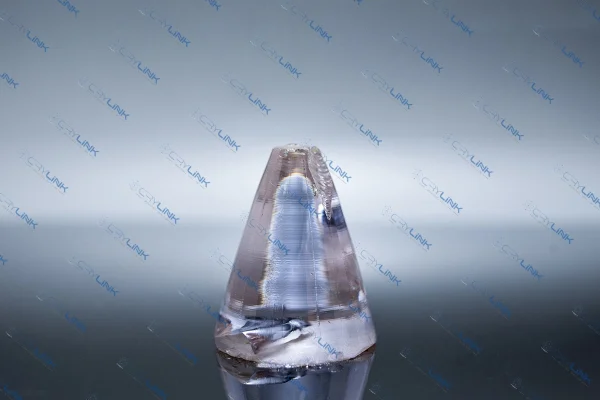
Silicon-Based Materials: The New Frontier
Silicon, a material that has long been the backbone of the electronics industry, is now making significant inroads into the domain of lasers. This transition from microchips to lasers might seem unexpected, but when one delves deeper into the properties and potential of silicon-based materials, the reasons for this shift become clear.
One of the most compelling arguments in favor of silicon in laser technology is its sheer abundance. As the second most abundant element on our planet, silicon offers a cost advantage that few other materials can match. This abundance translates to reduced material costs, making silicon-based lasers more economically viable, especially for large-scale applications or where budget constraints are a concern.
Beyond its abundance, silicon’s longstanding association with the electronics industry offers another distinct advantage: seamless integration with electronic devices. As the world moves towards more integrated systems, where electronics and photonics coexist harmoniously, silicon stands out as the bridge between these two realms. Its ability to facilitate integrated photonics means that we can envision a future where electronic and photonic components are part of a unified system, leading to more compact, efficient, and sophisticated devices.
Furthermore, the inherent flexibility of silicon-based materials is a boon for laser technology. Engineers and researchers can tweak and modify silicon’s properties to cater to specific laser applications. Whether it’s adjusting the bandgap for a particular wavelength or doping the material to enhance its conductive properties, silicon offers a versatility that is hard to match.
However, the journey of silicon in the world of lasers is not without its hurdles. One of the primary challenges is the material’s thermal properties. Silicon, despite its many advantages, has a high thermal resistance. In the context of high-power laser operations, where heat generation is significant, this resistance can lead to overheating and potential damage to the laser components. Efficient heat dissipation mechanisms become crucial to ensure the smooth operation of silicon-based lasers.
Another challenge is silicon’s natural tendency to absorb light at specific wavelengths. This light absorption can be detrimental to the efficiency of the laser, as it reduces the amount of light that is emitted. Researchers are actively exploring ways to mitigate this limitation, such as by pairing silicon with other materials that can counteract this absorption or by engineering the silicon at the nano-level to reduce unwanted absorption.
In essence, while silicon’s foray into the laser industry is relatively recent, its potential is undeniable. Its abundance, compatibility with electronics, and flexibility make it a promising candidate for future laser technologies. However, like all innovations, it comes with its set of challenges. As research progresses and we find solutions to these challenges, it’s not hard to imagine a future where silicon-based lasers are as ubiquitous as silicon-based microchips are today.
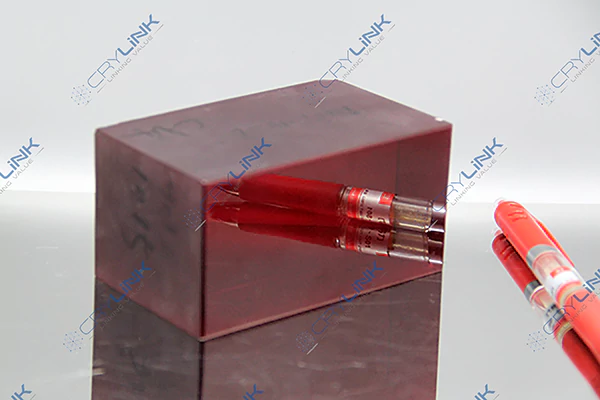
Other Noteworthy Crystal Materials in Lasers
The realm of laser technology is vast and diverse, and while YAG and silicon have garnered much attention, there are other crystal materials that have played pivotal roles in shaping the industry. Among these, sapphire and ruby crystals stand out for their unique properties and historical significance.
Sapphire crystals, primarily composed of aluminum oxide, are renowned for their exceptional hardness, second only to diamonds. This inherent hardness makes sapphire resistant to scratches and abrasions, ensuring longevity and durability in laser applications. But it’s not just the hardness that makes sapphire a preferred choice; its optical transparency across a wide range of wavelengths allows it to be employed in various laser systems. From ultraviolet to near-infrared lasers, sapphire’s broad transparency range makes it versatile and adaptable. Moreover, its thermal conductivity and resistance to chemical reactions further enhance its suitability for high-power laser operations where stability and reliability are paramount.
Figure 4. laser cutting
On the other hand, ruby crystals hold a special place in the annals of laser history. Comprising aluminum oxide infused with chromium impurities, ruby was the material of choice for the world’s first-ever laser, developed by Theodore Maiman in 1960. The chromium ions in the ruby crystal were pivotal in producing the red laser light, a breakthrough that laid the foundation for subsequent advancements in laser technology. While ruby lasers have been somewhat overshadowed by newer technologies, their historical significance cannot be understated. Beyond history, ruby’s fluorescence properties and ability to produce short pulses of laser light have found applications in various fields, from dermatology to holography.
In conclusion, the landscape of laser technology is enriched by the contributions of various crystal materials. While YAG and silicon have their rightful places in the spotlight, the roles of sapphire and ruby crystals, with their unique attributes and storied pasts, are indispensable in understanding the broader narrative of laser evolution. As the industry continues to evolve, these materials, along with others yet to be discovered, will shape the future of lasers in ways we can only imagine.

The Role of Crystals in Laser Technology
Crystals are not just passive components in lasers. They actively determine the wavelength, power, and efficiency of the laser. From frequency doubling to q-switching, the choice of crystal material can influence the very nature of the laser beam produced.
Conclusion
The world of high-power lasers is intricate and ever-evolving. The choice of crystal material, be it YAG, silicon-based, or any other, can profoundly impact the laser’s performance and application. As technology advances, we can anticipate the emergence of new materials that will further revolutionize the laser industry.
FAQs
- What are the primary applications of YAG crystals in lasers?
- YAG crystals are predominantly used in solid-state lasers for medical, industrial, and defense applications.
- How do silicon-based materials compare to traditional laser materials?
- Silicon-based materials are relatively new in the laser industry and offer the advantage of easy integration with electronic devices. However, they have their set of challenges, such as thermal issues.
- Why are crystals essential in lasers?
- Crystals determine the laser’s wavelength, power, and efficiency. They play a pivotal role in the laser’s overall performance.
- Are there alternatives to YAG and silicon-based materials?
- Yes, there are several other materials like sapphire, ruby, and various doped crystals used in laser technology.
- How do impurities affect the performance of YAG crystals?
- Impurities can introduce absorption centers in the crystal, affecting the laser’s efficiency and output power.


